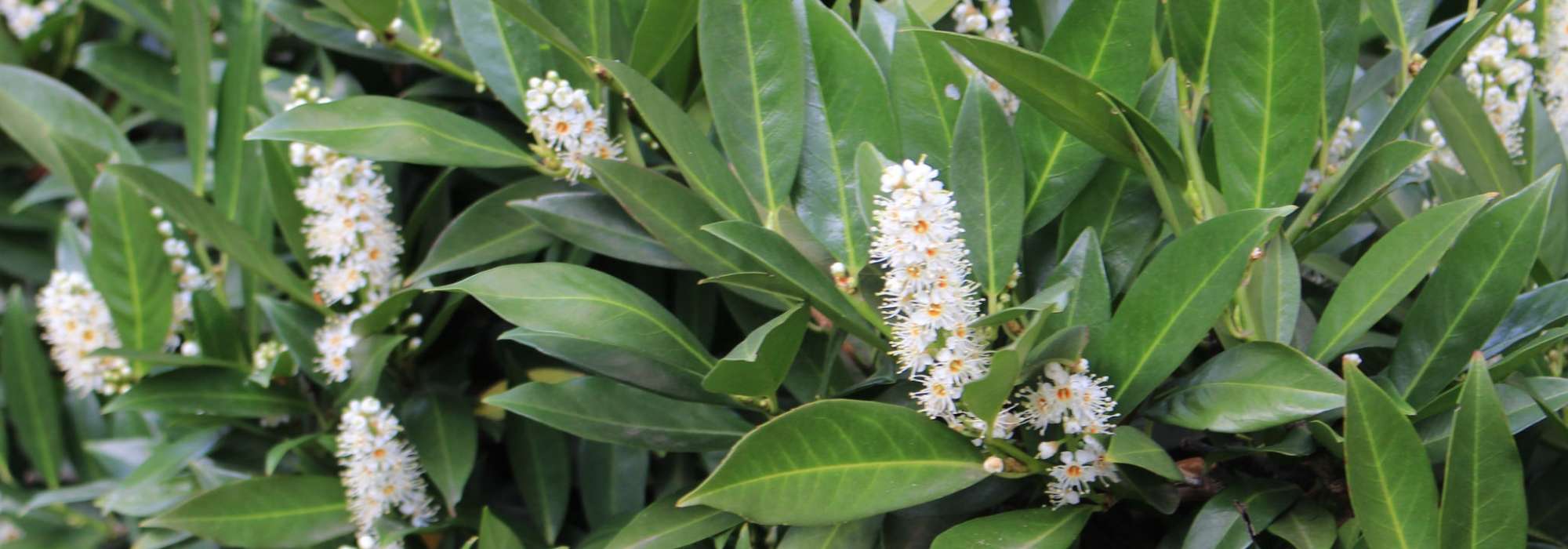
Palmate laurel and Portuguese laurel: planting, pruning and maintaining
Contents
Laurels, in a nutshell
- Laurels form a large family of evergreen trees or bushes often reserved for creating hedges
- Their large glossy foliage, rapid growth in any soil, hardiness and drought resistance have made them popular as hedge plants
- There is a great diversity of habits that allow for numerous uses
- Bay laurel (Laurus nobilis), oleander (Nerium oleander) or laurustinus (Viburnum tinus) are bushes that belong to other plant families and are not covered here.
A word from our expert
Cherry laurels or bay laurels (Prunus laurocerasus) form a large family with a noticeably different appearance depending on the cultivars. Caucasica and Rotundifolia, also known as bay laurel or Caucasian laurel, are widely used as hedge plants. They are easily recognisable by their large, glossy green leaves. Their height can easily reach 3 to 5 m if not pruned.
In contrast, Prunus laurocerasus Mount Vernon and Darts Low’n Green form a lovely carpet that hardly exceeds 40 cm in height. The latter can spread up to 3 m wide. Their leaves are smaller and duller.
Finally, the intermediate cultivars form medium hedges between 1 and 2 m high such as Prunus laurocerasus ‘Otto Luyken’, ‘Hebbergii’, and ‘Zabeliana’ with finer leaves reminiscent of bay leaves.
The flowering of all these unpruned laurels occurs in April-May, in the form of clusters of creamy white, melliferous flowers with a strong fragrance. They are followed by red berries that turn black at ripeness, hence their vernacular name of cherry laurel. Remember that the entire plant is toxic and should not be confused with bay laurel (Laurus nobilis) used in cooking.
Among the laurels, there is also the Portuguese laurel or Azores plum (Prunus lusitanica) which has a lighter conical silhouette than cherry laurel and medium-sized foliage supported by red petioles. Its spring flowering in fragrant cream clusters also attracts many pollinating insects. It deserves to be used as a specimen plant but can also form trimmed hedges which, unlike bay laurel hedges, can grow in very chalky soil and are not susceptible to diseases.
Description and Botany
Botanical data
- Latin name Prunus laurocerasus, lusitanica
- Family Rosaceae
- Common name Caucasian laurel, Portuguese laurel
- Flowering April to May
- Height between 0.40 and 5 m
- Sun exposure sun, partial shade to shade
- Soil type any loose and well-drained soil, calcareous for lusitanica
- Hardiness Good to excellent (-15 to -20°C)
A brief introduction is necessary to properly identify the subject of this sheet. Indeed, many plants bear the name of Laurels. They are always evergreen trees or bushes that have given rise to the term laurisylva (laurel forest). Laurisylva refers to a humid subtropical forest found in the Macaronesian islands (Canaries, Madeira…). It is home to trees of the genus Ocotea, Laurus, and Persea, as well as many ferns (Woodwardia…) and herbaceous plants such as the Madeira or Canary Geranium. With rainfall ranging from 500 to 1100 m and annual temperatures oscillating between 15 and 19°C, it is clear that we are far from our dear Caucasian laurels!
The bay laurel, noble laurel or laurel of Apollo is the well-known aromatic herb used in bouquet garni and which the Romans used to crown the heads of victors. This is Laurus nobilis in scientific terms, which belongs to the Lauraceae family while our famous Prunus is part of the Rosaceae! To add to the confusion, the laurel of Apollo is also used to form hedges, particularly in the Mediterranean region characterized by dry summers, and it also produces small black fruits resembling olives.
The oleander (Nerium oleander) is a staple of Mediterranean gardens with its fabulous summer flowering. The plant, belonging to the Apocynaceae family, is toxic and is easily recognized by the latex that flows when a part is cut. It often coexists with the viburnum tin (Viburnum tinus) in dry gardens, which is this time a persistent viburnum from the Adoxaceae family (formerly Caprifoliaceae) that blooms at the end of winter.

Prunus laurocerasus – botanical illustration
To summarise, we will focus here on the evergreen shrubs and trees of the genus Prunus which mainly include two species: laurocerasus and lusitanicus.
The cradle of the cherry laurel is located in the Balkans up to Turkey and along the shores of the Caspian Sea where it grows under the canopy of beeches. Its presence in Western Europe has been recorded since the 16th century, where it is used in hedges to create green cabinets. The trimmed shrub creates hedges 2 to 5 m high, very hardy (-20°C) that provide good insulation against wind, noise, and visual disturbances. In free form, it becomes an imposing tree, quite massive with a relatively airy crown that can reach 15 m in height and 8 m in width.
Its alternate leaves have a leathery texture like leather and a dark green glossy appearance on the top, matte and lighter on the underside. The simple lamina with crenate edges has a lanceolate shape measuring 12 to 17 cm long and 3 to 5 cm wide, borne by a pale yellow petiole of 1 cm. Rotundifolia has almost oval leaves while Otto Luyken, Hebbergii, and Zabeliana have a more tapered lamina with a pointed tip that resembles the leaf of the bay laurel. The low vigor of Otto Luyken allows for the formation of low hedges of about 1.20 to 1.50 m or to cover a slope. Zabeliana, Mount Vernon, and Dart’s low’n Green ‘Interlo’ with their spreading branches make excellent ground covers to fill a low-maintenance space exposed to both sun and shade.
The other species of laurel, Prunus lusitanica, is native to Spain and Portugal but has naturalised in the Basque Country. Although it prefers the rainy and warm climate of the southern Atlantic coast, it tolerates the drought of Mediterranean regions provided it has deep soil. Its growth is slower than that of the Caucasian laurel, which can be an advantage for maintaining a hedge, and its hardiness is around -15°C in well-drained soil. Its silhouette remains conical, reaching 10-12 m in height. Its foliage is slightly dentate, measuring 6 to 12 cm long, is much more elegant than that of the Caucasian laurel, less leathery, bronze at birth before turning into a very chic dark green with a pale green underside. It is borne by red petioles on reddish branches. The cultivar Angustifolia has even narrower foliage and rarely exceeds 4-5 m in height without pruning.
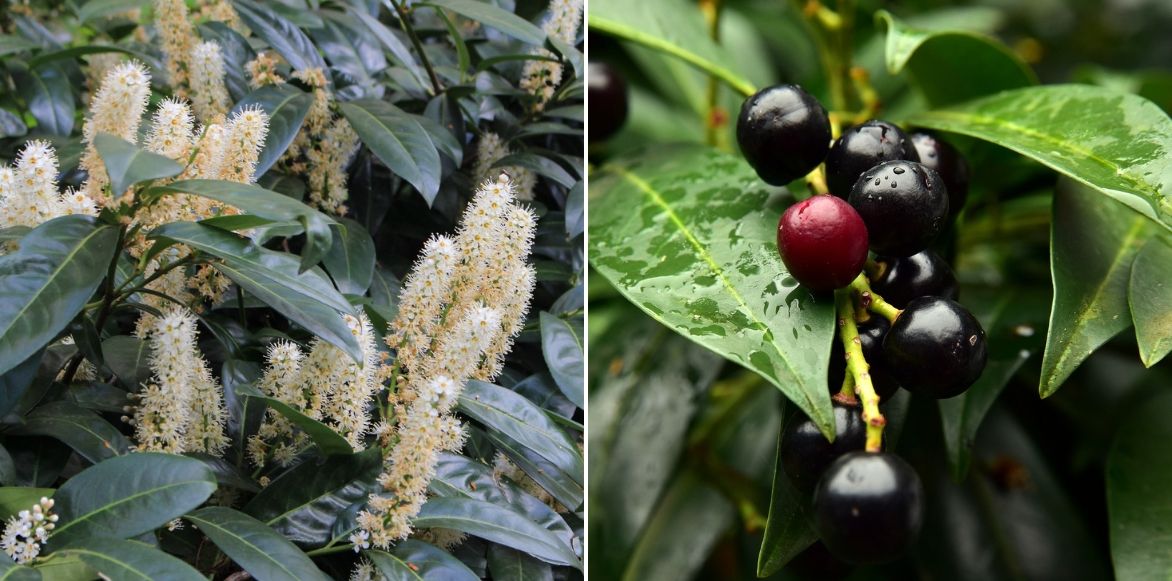
Prunus laurocerasus: flowers and leaves (photo Sebastian Rittau-Flickr) and berries
There are variegated cream forms in both species, but they tolerate less full sun.
The flowering of evergreen Prunus occurs in April-May in the form of narrow clusters, upright or pendulous, that arise in the axil of the leaves. They are composed of white or cream flowers less than 1 cm wide, with a sweet sometimes heady fragrance, and attractive to pollinating insects. The heart is often yellowish-green or even orange and carries around the edge stamens of different sizes with a central pistil, framed by a corolla of 5 to 10 petals. Too frequent pruning of laurels prevents flowering and fruiting from occurring!
The red then black berries that result from pollination by insects are decorative but are not edible. They contain cyanide like bitter almonds or the stones of apricots, other members of the Prunus genus, which belong to the category of fruit trees.

Prunus lusitanica: leaves (photo Ruth Hartnup-Flickr) and flowers (photo Donaleen-Flickr)
The main varieties of laurels
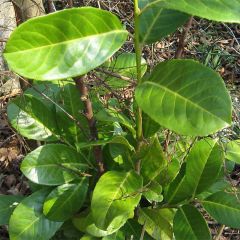
Prunus laurocerasus - Cherry Laurel
- Flowering time May, June
- Height at maturity 4 m
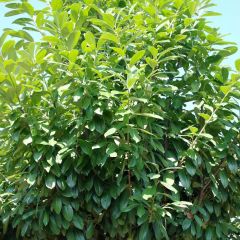
Prunus laurocerasus Novita- Cherry Laurel
- Flowering time May, June
- Height at maturity 4 m
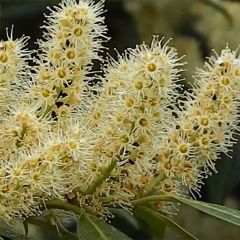
Prunus laurocerasus Herbergii- Cherry Laurel
- Flowering time May, June
- Height at maturity 4 m
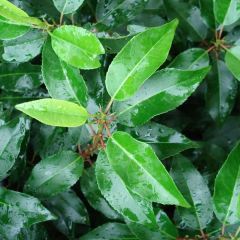
Prunus lusitanica Angustifolia - Portuguese Laurel
- Flowering time June, July
- Height at maturity 4 m
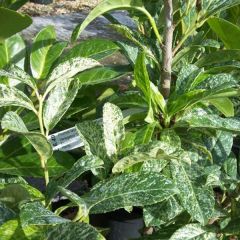
Prunus laurocerasus Marbled White - Cherry Laurel
- Flowering time May, June
- Height at maturity 4 m
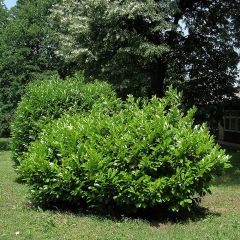
Prunus laurocerasus Etna- Cherry Laurel
- Flowering time May, June
- Height at maturity 2 m
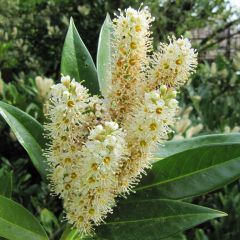
Prunus laurocerasus Otto Luyken - Cherry Laurel
- Flowering time May, June
- Height at maturity 1,50 m
Discover other Cherry Laurel - Commun Laurel
View all →Available in 1 sizes
Available in 1 sizes
Available in 5 sizes
Available in 1 sizes
Available in 4 sizes
Available in 1 sizes
Available in 5 sizes
Available in 1 sizes
Available in 1 sizes
Available in 1 sizes
Young plantation
Where to plant laurel?
Cherry Laurels are quite hardy (-20°C) and very easy to grow, really not demanding regarding soil and exposure, although they prefer partial shade. They require deep, well-drained soil, even dry but without excessive limestone. Limestone indeed makes the foliage lighter, potentially leading to chlorosis.
However, you need to ensure that both sides of the hedge are accessible for regular pruning. The vigour of the Caucasian laurel necessitates being very vigilant unless you select a less vigorous form like Hebbergii or even Otto Luyken, or opt for the Portuguese laurel.
It can also be criticised for being a bit too commonly planted. In addition to the “already seen” character, this massive use as hedge plants frequently results in the establishment of diseases such as shot hole disease or powdery mildew, to which the other species, Prunus lusitanica, is not susceptible. Furthermore, the latter combines more easily with other deciduous or evergreen bushes to create a varied trimmed hedge or a free-standing hedge. This species, slightly less hardy (-15°C), is not sensitive to limestone, tolerates drought well and prefers full sun. Its cultivar Variegata thrives better in partial shade.
When to plant?
Prefer planting in autumn unless the severity of winter might affect young plants of Prunus lusitanica, which can be planted in spring.
How to plant?
This plant is very easy to grow, within the reach of any amateur gardener.
- Soak the root ball in a bucket of water to thoroughly moisten it.
- Dig a hole three times wider than the root ball and aerate the soil around it with the tines of a fork.
- Add a few handfuls of sand and gravel to ensure good drainage around the roots.
- Add manure or decomposed compost if the soil is poor.
- Carefully untangle any roots that have circled in the pot before placing the plant in the hole, spaced 60, 80, or 100 cm apart depending on the desired height and growth rate. Tightly spaced plants will fill the space more quickly and grow less in height.
- Replace the soil and lightly firm it down.
- Water generously and mulch if possible (mowing waste, dead leaves, B.R.F).
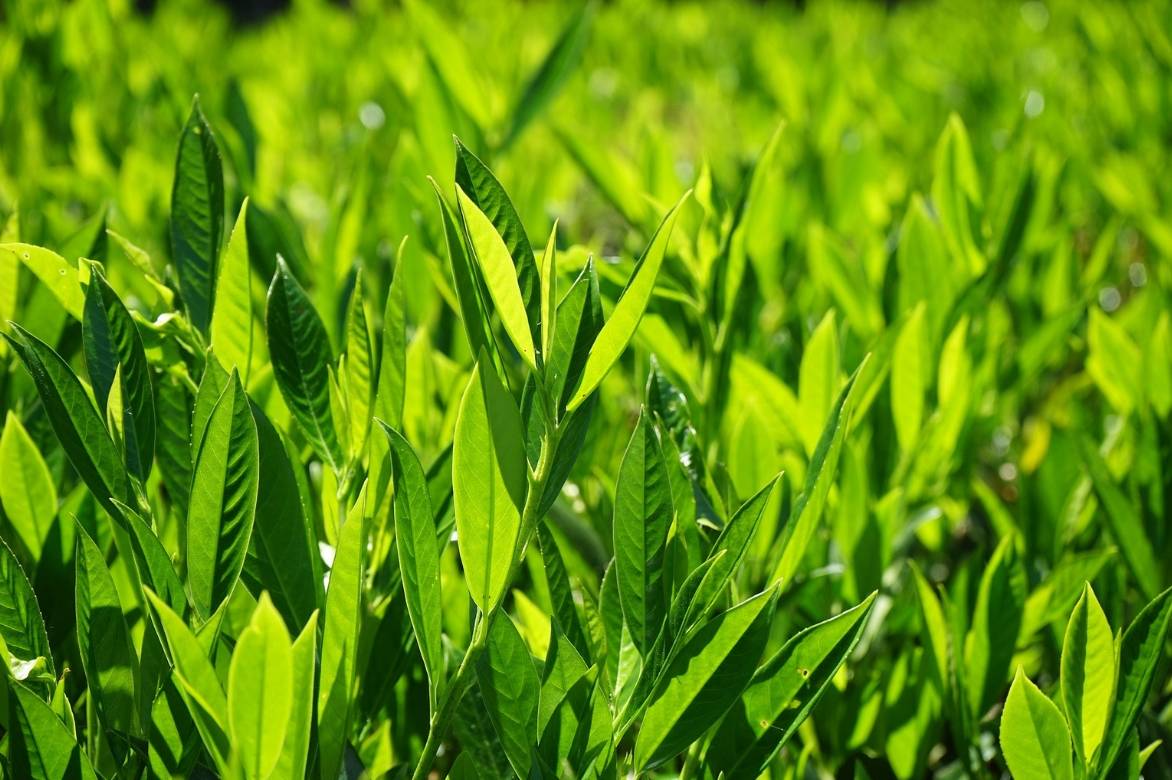
Read also
Bay laurel in 10 questions and answersPruning, maintenance, diseases
It is unnecessary to fertilise if you want to prevent the plant from growing excessively, but do remember to water during the first two years. The plant remains bushy at the base if it is pruned regularly and receives sufficient light, which explains its common use as a hedge plant.
Pruning of laurels can be done in May, after flowering, and a second time in September. Preferably use shears rather than an electric hedge trimmer, which tends to chew the leaves, causing them to blacken. Collect fallen debris as it releases cyanide that prevents other plants from growing.
Potential Diseases and Pests
Shot hole disease is caused by a fungus, Coryneum, which occurs in spring under mild and humid conditions. It manifests as small circular black spots perforating the leaves, which then yellow and fall. This disease does not endanger the plant but causes particularly unsightly damage and can spread to the entire cherry laurel hedge. Powdery mildew, which acts in warm weather in early spring or early autumn, leads to a whitish deposit on the leaves followed by distortions and perforations that result in leaf drop. If the damage is repeated, treat these diseases preventively with a fungicidal product (Bordeaux mixture and sulphur), especially after pruning. To avoid total and rapid contamination, vary the plants within your hedges. Attacks from aphids and scale insects are also to be feared.
Late frosts can sometimes affect the young shoots of Prunus laurocerasus, although new shoots quickly compensate for this inconvenience.
→ Read also: diseases and pests of the laurel palm or cherry laurel
Multiplication: propagation by cuttings
The simplest method of propagation is to propagate the bay laurel in September. Natural sowings can also be taken in autumn.
Propagation by Cuttings
Prepare a pot deep by filling it with a mixture of compost and sand.
- Take tips of shoots that are 15 to 20 cm long.
- Remove the leaves located near the base of the cutting.
- Dust the base of the cuttings with plant hormone.
- Insert them 2/3 of their length into a mixture of sand and turf that is moist, ensuring they do not touch each other.
- Place the culture under a frame, adding a sheet of transparent plastic held by stakes to humidify the atmosphere.
- In the following spring, separate the cuttings and repot them into individual pots filled with compost.
Place them in partial shade for 1 or 2 years before planting them out.
Uses and associations
Cherry Laurel is used to create fast-growing screens as well as windbreaks or backdrops for flowering scenes. The advantage is that it tolerates pruning well and can adapt to various shapes and heights, especially if you choose the variety according to its vigour.
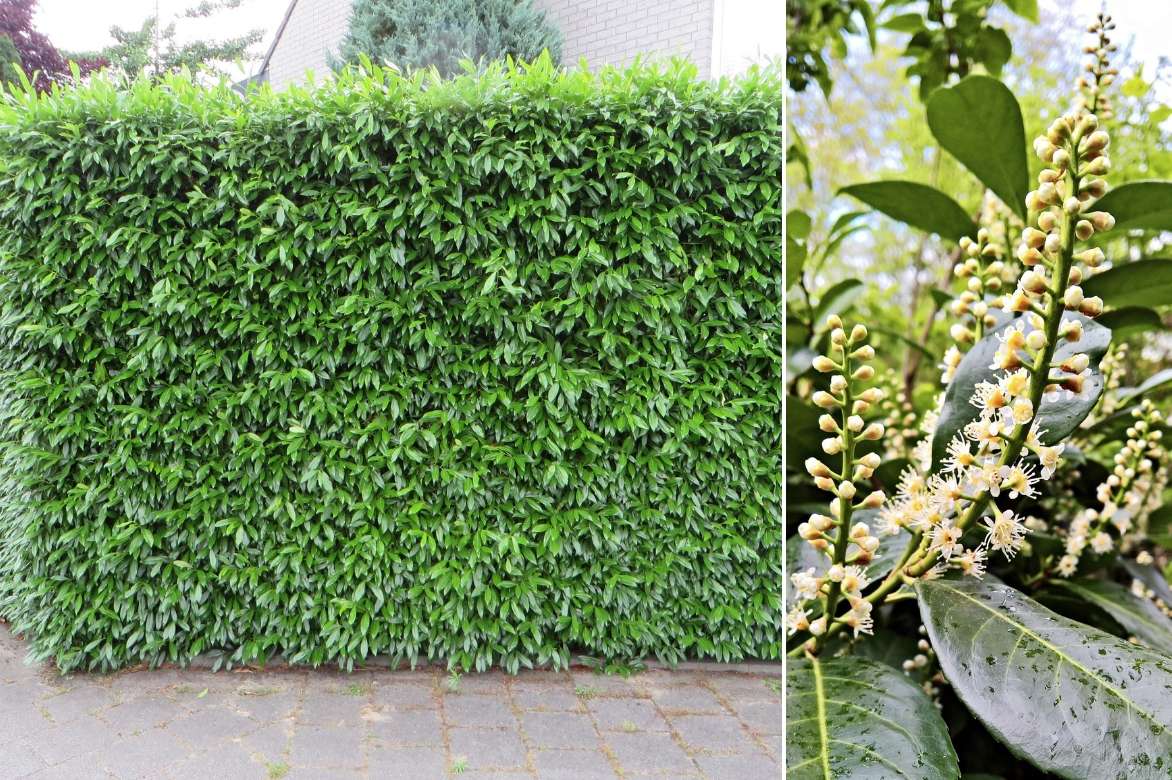
Trimmed Cherry Laurel hedge
It also serves as a very good sound insulator when the street is busy.
Ground-covering forms of cherry laurel are easily used to fill a shady space and require no maintenance regardless of the soil as long as it is draining and deep.
Portuguese laurel also makes an excellent trimmed hedge plant that also looks beautiful in a free habit with its conical shape and delicate dark green foliage. You can create a free hedge by spacing the plants 1.5 m apart. It associates better with other bushes than Caucasian laurel. A free evergreen hedge can thus consist of a mix of Elaeagnus ebbingei, Viburnum tinus, Rhamnus alaternus, Arbutus unedo, Photinia, Taxus (x) media, Pyracantha, Cotoneaster lacteus which will delight pollinators throughout the seasons. You can also intersperse deciduous shrubs such as Deutzia, Philadelphus, Japanese quinces, Vitex agnus-castus, Forsythias, buddleias…

An example of association in a free hedge: Prunus laurocerasus ‘Otto Luyken’, Deutzia crenata ‘Pride of Rochester’, Buddleia davidii ‘Pink Delight’, Cotoneaster lacteus, Viburnum tinus
It can be planted alone or accompany a flower shrub bed. Clear the base of its trunk to assert its presence and prevent an unsightly bare base.
Variegated forms such as lusitanica Variegata or laurocerasus Marble White serve to brighten shady areas.
To go further
Discover our range of laurels.
- Subscribe!
- Contents
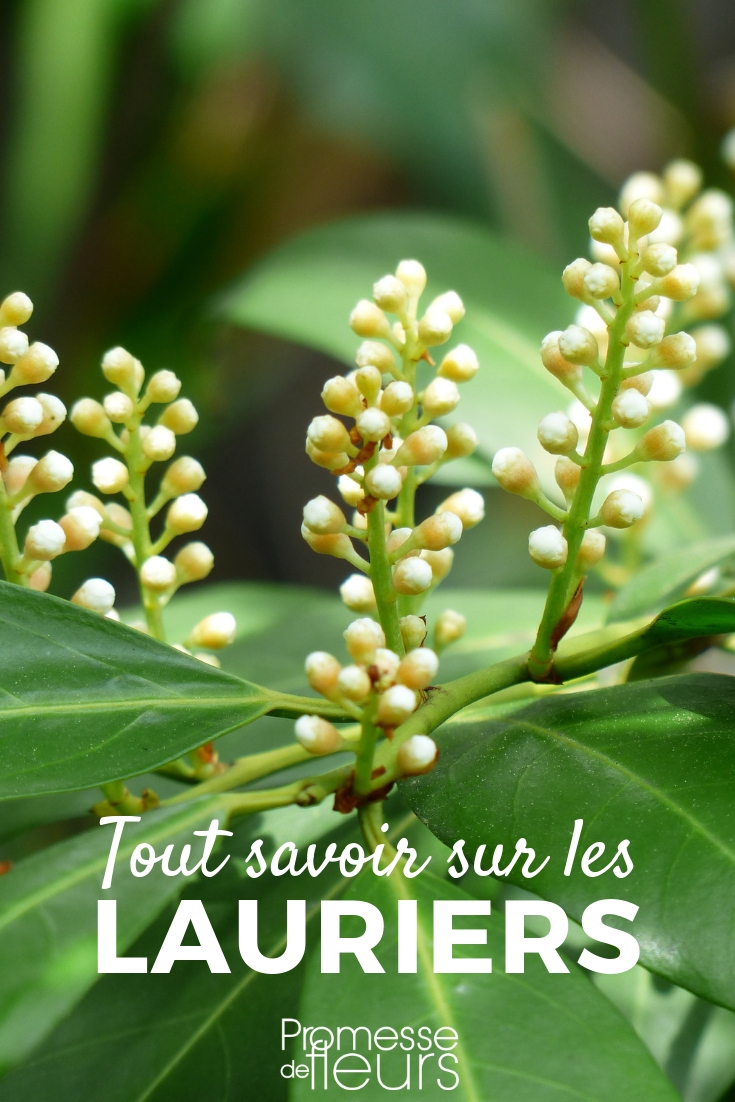
































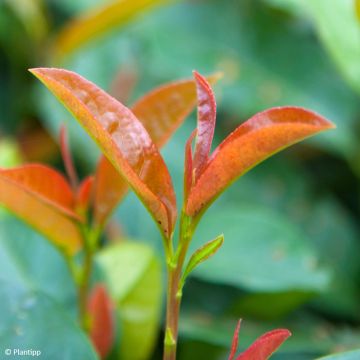

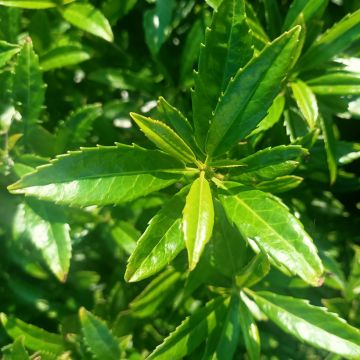


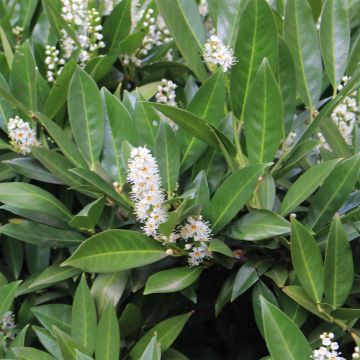
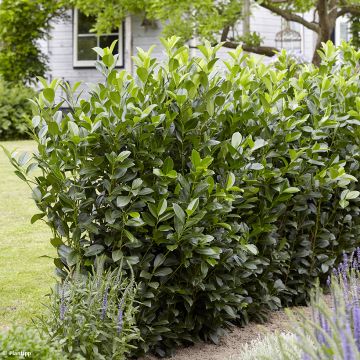
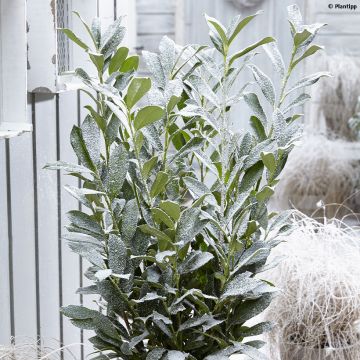
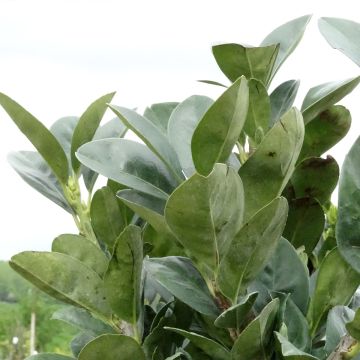
Comments